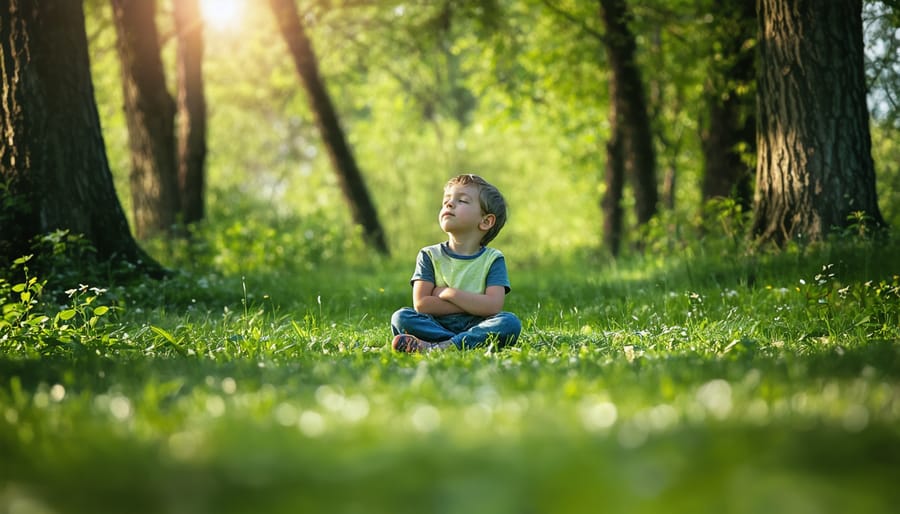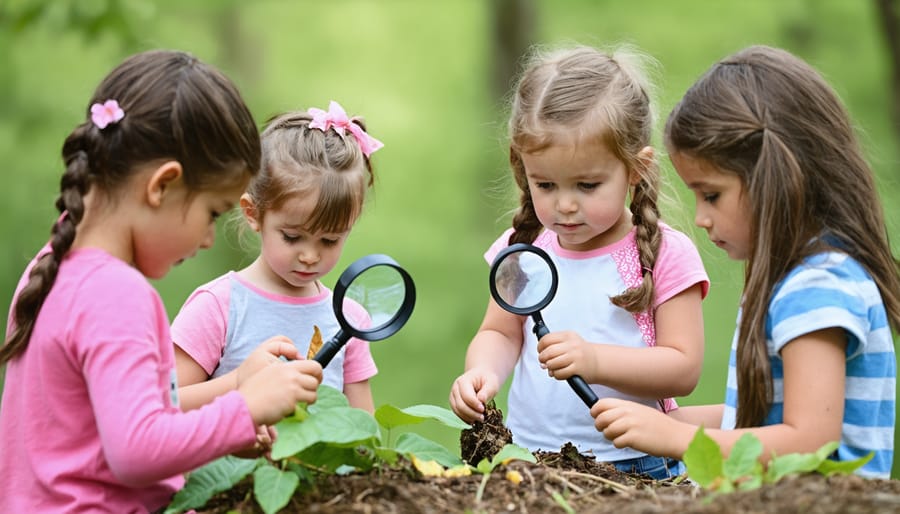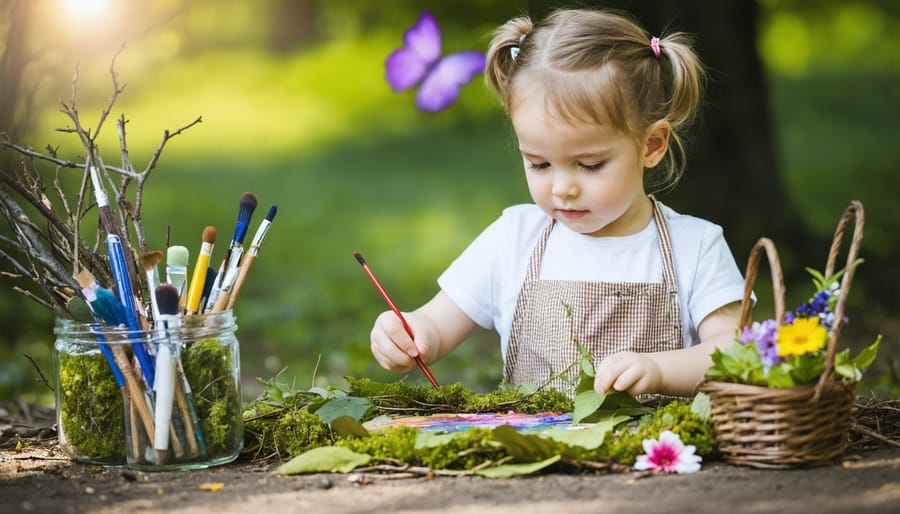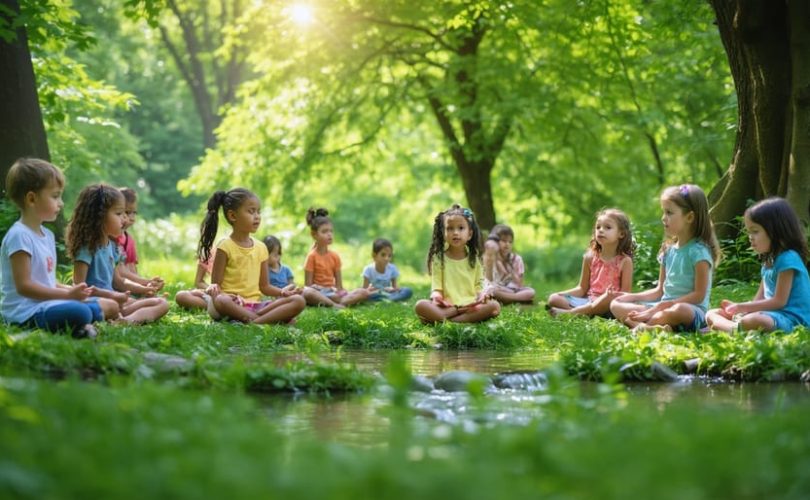Step outside with your child, take three deep breaths together, and notice how the fresh air instantly calms both body and mind. In our increasingly digital world, the simple act of connecting with nature offers a powerful antidote to stress, anxiety, and overwhelm – especially for young developing minds.
Research shows that just 20 minutes in nature significantly reduces cortisol levels and improves focus in children. When we combine this natural healing with mindfulness practices, we create a foundation for lifelong emotional resilience and mental wellbeing.
As both a parent and child development specialist, I’ve witnessed extraordinary transformations when families embrace nature-based mindfulness. From improved attention spans and reduced anxiety to stronger parent-child bonds, the benefits touch every aspect of childhood development.
This guide explores practical, science-backed ways to help children thrive through nature connection and mindful awareness. Whether you’re a parent seeking calmer days, a teacher creating peaceful classroom moments, or a caregiver supporting children’s emotional growth, you’ll find simple, effective strategies to implement today.
Let’s discover how the timeless wisdom of nature, combined with modern mindfulness techniques, can help our children navigate life’s challenges with greater ease and joy.
Why Nature and Mindfulness Make a Perfect Pair
The Science Behind Nature’s Calming Effect
Scientists have discovered fascinating evidence about nature’s healing effects on children, particularly regarding stress reduction and improved attention. When children spend time outdoors, their bodies respond by lowering cortisol levels – the hormone associated with stress. Studies show that even just 20 minutes in a natural setting can significantly decrease anxiety and improve mood.
The natural environment engages children’s senses in a gentle, non-overwhelming way. Unlike the sharp sounds and bright screens of indoor environments, nature provides what researchers call “soft fascination.” This means children can pay attention without mental fatigue, allowing their minds to restore and reset naturally.
Green spaces also promote better focus. Research from the University of Illinois found that children with ADHD showed significantly improved concentration after walking in parks compared to urban settings. The natural rhythm of rustling leaves, flowing water, and bird songs creates a calming effect that helps regulate children’s nervous systems and promotes emotional balance.
These benefits aren’t just temporary – regular exposure to nature can help build children’s resilience and emotional regulation skills over time.
How Outdoor Settings Enhance Mindfulness
Natural environments provide the perfect backdrop for mindfulness practice with children, offering a rich sensory experience that naturally draws their attention to the present moment. Unlike indoor settings, which can be filled with artificial distractions, outdoor spaces engage children’s senses in gentle, organic ways – from the rustling of leaves to the warmth of sunlight on their skin.
The ever-changing nature of outdoor settings also helps maintain children’s interest. A garden or park presents endless opportunities for discovery, whether it’s watching clouds drift across the sky, observing insects at work, or feeling different textures of bark and leaves. These natural elements create what many experts call “soft fascination,” where children’s attention is captured without overwhelming their senses.
Outdoor spaces also provide a sense of freedom and expansiveness that can help children feel more relaxed and receptive to mindfulness practices. The natural rhythm of outdoor environments – birds singing, branches swaying, water flowing – creates a calming atmosphere that supports emotional regulation and focused attention. This setting allows children to practice mindfulness authentically, without the pressure often felt in more structured indoor environments.
For children who struggle with traditional seated meditation, nature offers movement-based alternatives that can be equally effective in developing mindfulness skills.

Simple Nature-Based Mindfulness Activities for Children

Sensory Nature Walks
Sensory nature walks offer children a wonderful opportunity to connect with the natural world while developing mindfulness skills. Encourage your child to use all their senses as they explore – this helps them stay present in the moment and builds a deeper appreciation for nature.
Start by choosing a safe, accessible outdoor space like a local park or garden. Before beginning the walk, invite children to take three deep breaths and remind them that this is a special time for discovering nature’s treasures. As you walk, gently guide them through different sensory experiences:
For sight, ask them to spot different colors, shapes, or movement – like leaves dancing in the wind or butterflies floating by. Help them notice sounds by standing still for a moment with closed eyes – they might hear birds singing, leaves rustling, or insects buzzing. Encourage gentle touch experiences with safe natural objects like smooth stones, rough tree bark, or soft moss.
Make it fun by turning it into a game: “Can you find something that feels bumpy?” or “What’s the most interesting smell you can discover?” Remember to model mindful behavior yourself by sharing your own observations and showing genuine curiosity about their discoveries.
Keep the pace slow and relaxed, allowing children to stop and explore what interests them. End the walk by asking them to share their favorite discovery or moment from the experience. This helps reinforce positive memories and encourages reflection.
Nature Sound Meditation
Nature offers a symphony of calming sounds that can help children develop mindfulness and reduce anxiety. Just like other meditation techniques for anxious children, nature sound meditation is simple yet powerful.
Start by finding a quiet outdoor spot with your child – this could be your backyard, a local park, or a nature trail. Have them sit or lie down comfortably, and encourage them to close their eyes. Guide them through these gentle listening exercises:
1. Ask them to count different sounds they can hear (like birds chirping, leaves rustling, or water flowing)
2. Invite them to focus on one particular sound and notice how it changes
3. Encourage them to imagine they’re recording these sounds in their mind, like a special nature playlist
Dr. Sarah Chen, a child psychologist, shares: “When children practice mindful listening in nature, they’re not just relaxing – they’re developing crucial attention skills and emotional awareness.”
Keep sessions short, around 5-10 minutes for younger children. You might say, “Let’s be nature detectives with our ears!” Make it playful and praise their observations. Some children enjoy drawing or writing about the sounds afterward, creating a deeper connection with their experience.
Remember, consistency matters more than duration. Try incorporating these listening moments into your daily routine, perhaps during morning walks or after-school outdoor time.
Mindful Nature Art
Creating art with natural materials offers a wonderful opportunity to combine mindfulness with creative expression. When children gather leaves, pinecones, or stones for their artwork, they naturally slow down and observe their surroundings more carefully. This heightened awareness is mindfulness in action.
Start by taking your children on a nature walk to collect materials. Encourage them to notice the different colors, shapes, and textures they find. Ask them to pause and feel the smoothness of a river rock or examine the intricate patterns on a fallen leaf. This sensory exploration helps ground them in the present moment.
Once you’ve gathered materials, find a quiet space to create. Simple projects like leaf printing, rock painting, or creating nature mandalas can be deeply meditative. The key is to focus on the process rather than the final product. Let children arrange and rearrange their natural treasures without pressure to achieve a specific outcome.
Nature art journaling is another meaningful activity. Children can press flowers, sketch what they observe, or create collages using found materials. This practice combines artistic expression with mindful observation and can become a cherished ritual for processing emotions and experiences.
Remember to encourage reflection after the activity. Ask children how it felt to create with nature’s treasures and what they noticed during their creative process. These conversations help reinforce the connection between artistic expression and mindful awareness.

Building Mental Resilience Through Nature Connection
Emotional Regulation in Natural Settings
Nature provides children with a unique environment for emotional development and self-regulation. When children spend time outdoors, they naturally encounter situations that help them process and manage their feelings. Research shows that natural environments for emotional healing offer children a peaceful space where they can safely experience and work through their emotions.
Consider Sarah, an elementary school counselor, who observed that anxious students often became calmer after spending time in the school garden. “The simple act of watching butterflies or feeling the breeze helps children center themselves,” she explains. “It’s like nature provides a gentle reset button for their emotional state.”
The natural world offers numerous tools for emotional regulation: the rhythmic sound of waves, the gentle rustling of leaves, and the feeling of grass beneath bare feet. These sensory experiences activate the parasympathetic nervous system, helping children transition from stress to calm. When feeling overwhelmed, children can use these natural elements as anchors to ground themselves and regulate their emotions.
Parents and caregivers can encourage this process by creating opportunities for children to interact with nature during emotional moments. Something as simple as taking deep breaths while watching clouds or holding a smooth river stone can become a powerful self-soothing technique that children can rely on throughout their lives.
Creating Lasting Coping Skills
When children develop a connection with nature through mindfulness practices, they gain more than just momentary peace – they build lasting emotional resilience. Research shows that regular exposure to nature-based mindfulness activities helps children develop sustainable coping mechanisms they can use throughout their lives.
Dr. Sarah Chen, a child psychologist specializing in nature therapy, explains, “Children who learn to ground themselves through nature experiences develop an internal toolkit they can access anywhere. Whether it’s remembering the sound of rustling leaves during a stressful test or visualizing their favorite peaceful spot in the garden, these skills become second nature.”
Parents often report that their children continue to use these techniques independently long after initial introduction. Emma, mother of two, shares, “My daughter now automatically goes to our backyard when she’s feeling overwhelmed. She’ll spend a few minutes watching the birds or touching the grass, and I can see her whole demeanor change.”
To help children build these lasting skills:
– Encourage regular practice during calm moments
– Help them identify their favorite natural spaces
– Teach them to notice and name nature’s patterns
– Create simple rituals they can replicate anywhere
– Model using nature for your own stress relief
Remember that consistency is key. The more frequently children engage with nature mindfully, the more automatic and effective these coping skills become. Over time, this nature-mindfulness connection evolves into a lifelong resource for emotional regulation and mental wellness.
Tips for Parents and Teachers
Getting Started Safely
Before embarking on your nature and mindfulness journey with children, it’s essential to establish some basic safety guidelines and preparation steps. First, choose familiar and accessible locations for your initial outdoor experiences, such as a local park or your backyard. This helps create a comfortable environment where children feel secure exploring.
Always check weather conditions before heading out and dress appropriately. Bring essentials like water, sunscreen, insect repellent, and a basic first-aid kit. For younger children, maintain a close supervision ratio while still allowing them the freedom to explore safely.
Start with short sessions of 15-20 minutes and gradually increase the duration as children become more comfortable. Be mindful of any allergies or physical limitations within your group, and plan activities accordingly. It’s also important to teach children basic outdoor safety rules, like staying within sight and not touching unfamiliar plants or animals.
Create a routine of checking the area for potential hazards before beginning any mindfulness activities. Establish clear boundaries and a simple signal, like a gentle bell or whistle, to gather the group when needed. Remember that some children may initially feel uncertain about outdoor experiences, so maintain a patient and encouraging approach.
Consider partnering with other parents or educators who have experience in outdoor activities with children. Their insights can be invaluable in creating safe and meaningful nature-based mindfulness experiences.
Making It a Regular Practice
Making nature mindfulness a daily habit doesn’t have to be complicated or time-consuming. Start by setting aside just 5-10 minutes each day for outdoor observation and reflection. This could be during morning walks to school, afternoon playground time, or evening backyard exploration.
Create a routine that works for your family’s schedule. Perhaps begin each day by stepping outside to feel the morning air and listen to birds, or end the day by watching the sunset together. These small moments can become powerful calming mindfulness practices that children look forward to.
Keep a nature journal near your door or in your bag to encourage spontaneous moments of observation. Set reminders on your phone if needed, but try to make these practices feel natural rather than forced. Even on busy days, you can practice mindfulness by simply noticing the clouds while walking to the car or feeling the breeze during recess duty.
Remember that consistency matters more than duration. A daily five-minute nature connection is more beneficial than occasional hour-long sessions. Encourage children to share their observations and feelings about these experiences, making it a collaborative and enjoyable activity rather than another task to complete.
As the seasons change, adapt your practice to embrace new natural elements – from spring rain to winter frost – keeping the experience fresh and engaging year-round.
As we’ve explored throughout this article, the connection between nature and mindfulness offers a powerful pathway to better mental health and emotional well-being for children. By incorporating simple practices like outdoor meditation, nature walks, and sensory exploration into daily routines, we can help young ones develop essential coping skills while fostering a deeper appreciation for the natural world.
Remember, you don’t need elaborate equipment or extensive training to begin. Start small by spending just ten minutes outside each day with your child, practicing mindful observation and breathing. Watch as their curiosity grows and their stress levels decrease. The benefits of nature-based mindfulness extend far beyond the immediate moment, helping children build resilience, emotional awareness, and a lifelong connection to the environment.
Take that first step today. Whether it’s sitting quietly in your backyard, exploring a local park, or simply watching clouds from a window, every moment spent mindfully connecting with nature is an investment in your child’s well-being.



